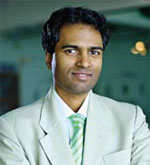Against the baseline level of 1998, the Dubai Chamber of Commerce and Industry building has been able to achieve a 77% reduction in water and a 47% reduction in electrical consumption.

B Surendar
Against the baseline level of 1998, the Dubai Chamber of Commerce and Industry building has been able to achieve a 77% reduction in water and a 47% reduction in electrical consumption. The 15-year-old building, along the creek in the historical Deira part of Dubai, is the first LEED EB in the Arab world. Jagath Gunawardena, its Manager (Projects and Building Development), says that the building has been able to achieve an 8-9% reduction in operating cost, a 7.5% increase in building value and an accumulated savings of Dh7.1 million since 1998.
The Chamber building is an example of a client showing faith in facilities management to achieve power efficiency and water efficiency. According to industry figures, facilities management has a 70% impact on the efficient running of a building and even its aspiration for green building status. Gunawardena vouches for that by saying that in an EB certification process the role of a facilities manager is crucial.
Generally, he says, the onus is on the facilities manager to regularly re-commission and retrofit the building, to regularly analyse data and to switch off equipment when not necessary. Switching off, he says, is not something that can be flippantly dismissed as a minor exercise in savings. His words resonate with what another building in Dubai achieved through switching off its chillers and FAHUs in the night – a savings of 15% every year. The fact that the owner of the building achieved this without investing anything and by merely operating the facility the way it should be operated is noteworthy.
In that context, building owners, consultants and contractors would probably do well to consider involving an FM specialist from the design stage of a building through to its hand over, a practice that is “more honour’d in the breach than the observance”, to quote Shakespeare. Other less-than-ideal situations include the overdesign of MEP (usually 200% of HVAC), lack of MEP knowledge in BMS design personnel and the fact that designers of a building never return to evaluate its performance and negative features and, worse, go on to replicate the design, replete with mistakes.
Thrift, planning, history and collaboration are mind-entities worth their weight in gold.
Copyright © 2006-2025 - CPI Industry. All rights reserved.